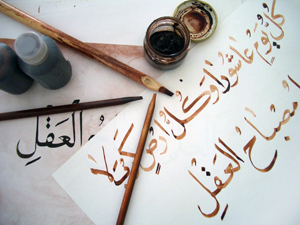Home page
» ART
» Calligraphy
About calligraphy It is an art of writing of Arabic letters in various forms, which was mastered by the Islamic world. Though it is not considered as one kind of art, it was in constant developing as a separate branch of art. The calligraphy which reflects the cultural values of the Islamic world is accepted presently as the symbol of Islam. Calligraphy was formed at the initial phase of Islamic history. The history of calligraphy started with decorative imaging of letters. In view of fact that in Islam copying of lively beings was forbidden so the art of writing was more developed. Respect for God sayings and the attempts to write Koran in the best way had caused formation of the art of calligraphy. In this connection tazhib, abru and cild arts were emerged and even art of paper, ink turned to be branches of art. Gradually, the calligraphy turned into the one of the main types of art in the Muslim world and to the parameter of good writing, literacy rate. It is possible to bring many examples of that state officials, writer, poet, and scientists and artists were also good calligraphers. Calligraphy has been previously more used in writing books. Later the calligraphy art was used in architecture. As a result of activity of calligraphers 6 main calligraphy kinds of the Arabic alphabet were created: suls, naskh, muhaqqaq, reyhani, touqi and raqa. All together they are called as classic six. These writing kinds were among the most in calligraphy. These kinds were even increased due to pen’s structure, used area. The calligraphy in Azerbaijan The art of calligraphy is in Azerbaijan begins with the work of the Mubarak shah Zarrinqalam Tabrizi. The famous Arab calligrapher of the XIII century, Djamaleddin was one of six students of Mastasim. They were entered in the history of calligraphy as the six-masters . The six included one more Azerbaijani master- sheikh Ahmed Suhravardi. Mubarak shah Zarrinqalam was well aware of all six classic calligraphy lines and he had many followers writing on that calligraphy. One of the most well-known calligraphers of XV century Jafar Tabrizi was originally from Azerbaijani Turks, one of the great calligraphers of Azerbaijan, and he was a teacher of many calligraphers able to write in nastaliq, taliq and suls styles, as well as in classic styles. Jafar\'s life coincides with the period of invasion of Central Asia by Timur. In Tabriz Jafar worked in the palace of Miranshah, the son of Timur. Later he likewise other masters, artists and calligraphers shifted to Herat, at one of Timur\'s son- Shahrukh. Here he worked under the Shahrukh\'s son Baysunqur and headed a small library, workshop. There were about 40 calligraphers engaged in coping of manuscripts. Besides, there were miniature masters, those worked with gilded water, skin processors and decorators, restorer and bookbinders. Jafar Tabrizi often presented reports to Baysungur Mirza on the works done in the library. One of these reports (June 1427) is kept now at the Topkapi Palace Museum in Istanbul. There are information in the report about 18 miniature-painter, calligrapher, bookbinder, translators, master worked with gilded water and others besides a description of the library’s activity. During the living at place of Prince Baysunqur Jafar Tabrizi had copied a number of books that are well-known in the history of calligraphy. Shahname of Firdowsi (1430), Gulistan of Sadi (1427), Nizami\'s Khamsa (1431) are perfect examples of calligraphy copied by him with nastaliq style. These copies are kept at the museums and the famous libraries of Paris, Dublin, Tehran, Istanbul, St. Petersburg. The great artist died in 65-year-old in city of Herat in 1480.
|
